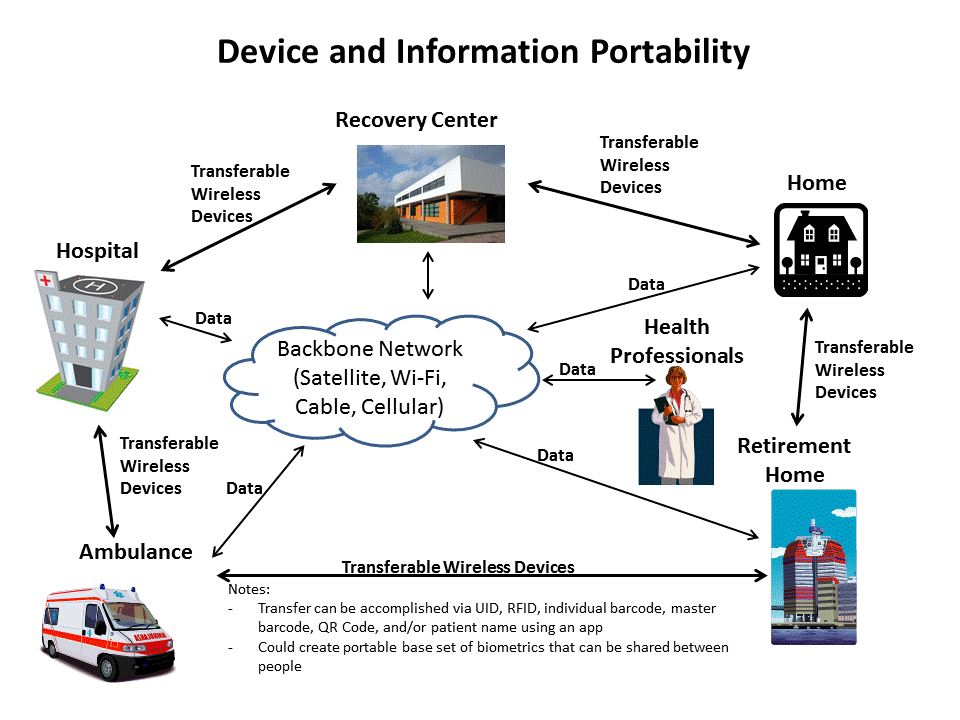This site represents a Technology Based Initiative to create a Worldwide Market-Driven Affordable Whole Healthcare System and is seeking forward thinking and innovative companies, organizations, Universities, and individuals to participate and lead in the Vision, Standards, and the Development of the System... Check back for updates (lots more data to input). Site History

There are a number of 1st Responder Emergency Vehicles (Fire Rescue, Ambulance, Air Ambulance, Mountain Rescue Vehicle, Mine Rescue Vehicle, Search and Rescue Team Vehicle, Hazardous Materials Team Vehicle, Lifeguard Vehicle, Disaster Recovery, etc.), each with a set of equipment that may be custom to their mission. These exist today, and it is envisioned that efforts are leveraged off of existing players in this area to incorporate the new devices and features.
The System uses small “Plug and Play” devices, common “Look and Feel” interfaces on Standard PCs, Smartphones, and Tablets, with online Practical and Simulation Training, Help, and Instructions and High-speed anywhere Network Access for Telemedicine support.
These “System-in-a-Boxes” can use the same configured “core” System functions, and just have the unique devices and specific mounting for the different vehicle configurations. The System transfers a lot of the work to technology with a common look-and-feel interface, which results in less training, less mistakes, and the use of less trained individuals.
Since Medical Devices and additional APPs are “Plug and Play” Devices and are continuing to become smaller with more functionality, vehicles can add incremental improvements over time. The devices are mainly connected wirelessly and can be easily swapped in, and they can be remotely managed (monitored, upgraded, debugged) so that the vehicles are operational more of the time.
The devices and System features all work together and the System automatically collects visual, audio, machine-to-machine, and manually entered data and then stores and analyzes it using local and/or Cloud resources. The System can use the data to create intelligent examination/treatment decision trees and provide advice as needed, and/or connect to a Doctor via telemedicine.
New technologies including specialized devices, APPs, and High Speed Networks can support new advanced portable Emergency Kits (e.g. new evolving “Tricorders”, smartphones, and other devices) that can be incorporated into the System, and support Triage, Telemedicine, and being able to setup and stabilize more individuals in the field.
Another potential item would be Search and Rescue Robotic Devices that can be equipped with audio, camera, video for two way visual communication, light, “tricorder”, network repeater, “RF or other location technology”, Telemedicine, and visual issue recognition tools.
Scenarios:
-
You want to better respond to patients in the field, and have additional resources when you need them
-
You want to improve the network and telemedicine capability
-
You would like some intelligent machine assisted guidance in performing examinations and treatments in the field
-
You want to be able to help support a field or local area emergency shelter in case of an area disaster
-
You would like to have more access to information about patients (picture, name, contact, medical alerts)
-
You want to lower costs (purchase, support, maintenance, down-time, upgrade) by leveraging off of high volume commercial systems and common “System-in-a-Box” configurations for a given vehicle
-
You want to increase the operational time of your vehicles by increasing their availability (repair, upgrades, maintenance, calibration, etc.)
-
You want to improve the medical capability and Future Proof your vehicles so that they can easily get incremental device and application improvements over time
-
You want to be able to easily transfer monitoring devices (and the data) between patient, emergency vehicle, and hospital, recovery center, etc.
System Features
-
Common “Look and Feel” for applications and devices, that can be controlled from PCs, Tablets, or Smartphones
-
Plug and Play Telemedicine
-
Intelligent Adaptable Exam Decision Tree with Visual and Symptom matching
-
Multiple methods of input/output (visual (camera or glasses), verbal, machine-to-machine, or manual input)
-
Plug and Play Devices and Applications
-
Online, Real-time, and On-Site Scenario Testing
-
The Vehicle can be configured to provide a high-speed high-availability perimeter network for interconnectivity using one or more technologies for redundancy
System Components:
-
Smartphone, Tablet, and/or PC with downloaded APPs
-
Selected System-in-a-Box devices and physical configuration for different types of Vehicles
-
Any additionally desired Devices/APPs
-
Any additionally desired High Availability Features (batteries, satellite network connection, etc.)
-
Classroom Training (on-line training is part of base system)
-
Subscription Service for Telemedicine (if desired)
Use Case - 1st Responder Emergency Vehicles



